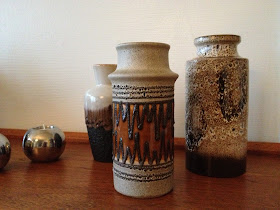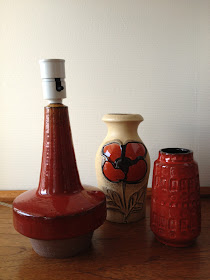This is gonna be a long one, please bear with me.... What I'm gonna show you today not only makes my heart beat faster, it makes it pound like crazy.
As an architect I never stop being amazed by modernism. I can't think of any other era as groundbreaking as modernism, when the whole concept of living and how we percieve our surroundings were so profoundly reinvented. Imagine how brave these architects were, even today it's often hard to convince clients to have an open mind.
Today, lots of houses copy the style of the houses from this great era, but in my opinion, seem to copy the aesthetics but leave out the invention and meaning. The mid- century architects, that we all love and admire, wouldn't want us to copy what they did, but to keep on reinventing. We should be inspired by the bravery rather than the style, keep on preserving modernist buildings as great examples of the extremes the architects went to to contribute to the evolution of the field of architecture.

We have one of these great examples in Oslo. Planetveien 12 (12, Planet lane, even the adress points to the innovative space age ideas of the time) was designed by one of our greatest modernist architects, Arne Korsmo, as a home for himself and his wife Grete Prytz Kittelsen. You may recognize her name, she is the lady behind the iconic lotus design for Cathrineholm that we all know and cherish. She was a great artist and designer whose beautiful objects can be found throughout the house, as well as the work by their close friend, great modernist artist Gunnar S. Gundersen. The house is an example of the modernist idea of the "gesamtkunstwerk" (the complete work of art, Bauhaus), the merging of different art forms, like architecture, furniture, objects and art.



Korsmo made a great contribution to the Scandinavian Design movement and introduced the field of indusrial design in Norway. He is well known for his elegent tableware. His intention was always to design both the exterior and interior of his houses, and often the furniture and tableware too, just like his nordic colleagues Arne Jacobsen and Alvar Aalto did.
The house is one of three (originally) identical houses in a row. Korsmo and Prytz Kittelsen lived in the middle of the three. The houses have received a lot of international attention. Not only did they introduce the international principles for glass and steel architecture in Norway (as seen in, amongst others, Mies van der Rohe's great buildings), they were also a manifest for a new, modern and flexible way of living.
In collaboration with his colleague Christian Nordberg- Schulz, Korsmo designed the three modernist "experiments", as they called them, where they explored new ways of living. Korsmo's home was by far the most radical. Togethet with his wife he cfreated a home that reflected modern life with it's floating boundaries between work and leisure as well a s the public and the private.
The street facade is made of translucent Thermolux panels. This was very unusual at the time and is very rarely seen even today. On the sheltered garden side, the house is extremely, and in 1954, shockingly transparent.
Planetveien 12 is an experiment with standard elements and modules, much like the house of Korsmo and Prytz Kittelsen's american friends, Charles and Ray Eames. The house was inspired by both the Case study project (if you don't already know it, google it- these houses are as groundbreaking as they are gorgeous) and japanese architecture. It was a product of Korsmo's ideas of an organic and flexible way of living, the home mecano, as he called it. His home is on a list of twelve buildings which are considered the most important buildings of post- war Norway. It managed to put norwegian modernism on the world map and inspired the structuralism of the sixties.
The interior from 1954 is kept in it's original condition. Both the exterior and the interior has been protected by law after Prytz Kittelsen died two years ago. She very much contributed to how the house turned out, it was her home and workplace for more than fifty years.
To Korsmo and Prytz Kittelsen, a home was just as much a place to work as to relax and entertain. Planetveien 12 was a flexible home that answered to the modern individual's need for relaxation, work and social life. The stair to the second floorhad an engine and could be lifted when more floor space was needed for dancing and the stairs down to the basement could be hidden away. The main space, which is an untraditional combination of living room, workspace and entertaining area, has a large seating arrangement that consists of 100 square cushions that runs along the walls and can be transformed into an amphitheatre for performances. The white panels over the fireplace can be turned to become blackboards for creative spells and there is storage behind every surface. One of the living room walls is made of tall panels that can be reversed to give the objects on display another background color. Legendary silver and enamel pieces by Prytz Kittelsen are on the shelves.







The rest of the house was equally flexible. The arrangement of plywood modules in the kitchen could easily transform the space from informal everyday kitchen to dining area or workspace. I used to think the surfaces were made of teak veneer, but they're actually mahogany. The beds upstairs could be folded away to extend the floor space.










The creative couple were friends with Utzon and Aalto, who visited the house regularly. It is said that Prytz Kittelsen was such a great hostess that Aalto always insisted on being seated next to her. Prytz Kittelsen got the "work home" she wanted. She had her workshop in the basement, where her lovely portrait was taken by Vogue in 1961. The large oven for her enamelware is still there. This is where she designed all the enamel objects, silverware and jewellry that made her one of Norways greatest post- war designers. She divorced Korsmo, who died in the late sixties, but continued living in the home they created until she passed away two years ago.

Prytz Kittelsen never stopped loving the house with all the objects the couple filled it with. "I have always loved it here at the edge of the woods, I've cherished every day I can just be here. The light, the colors, the rooms, I never tire of it."
In her last will, Prytz Kittelsen wanted the house to be lived in, instead of becoming a museum. It was sold after her death. The house is protected by law, which means that no alterations of the exterior or interior can be made, this also applies to the furniture. I'm really envious with the couple who bought it, I hope they love it as much as I do...








































































